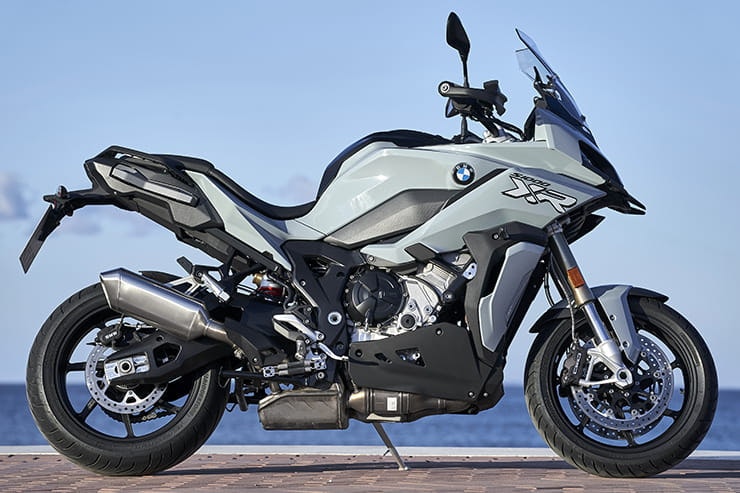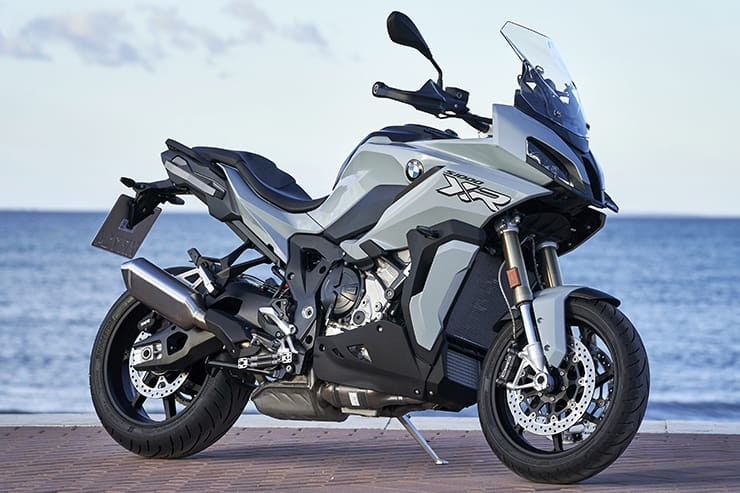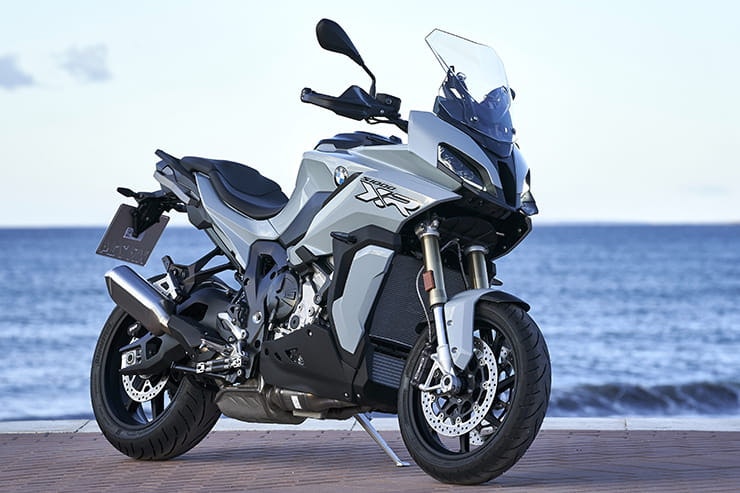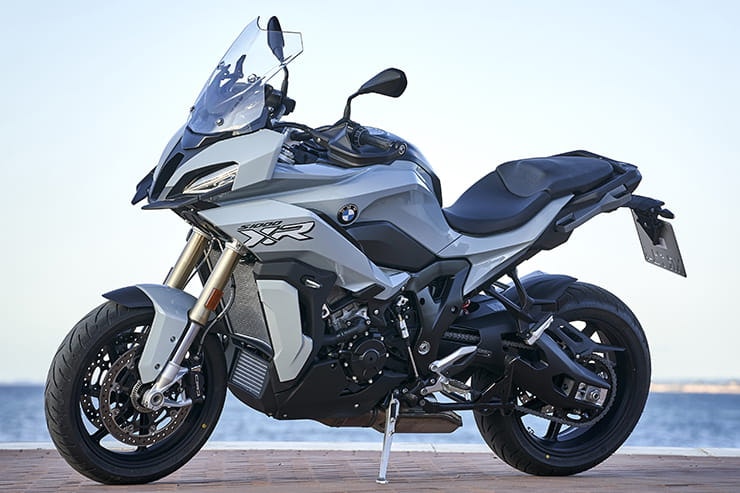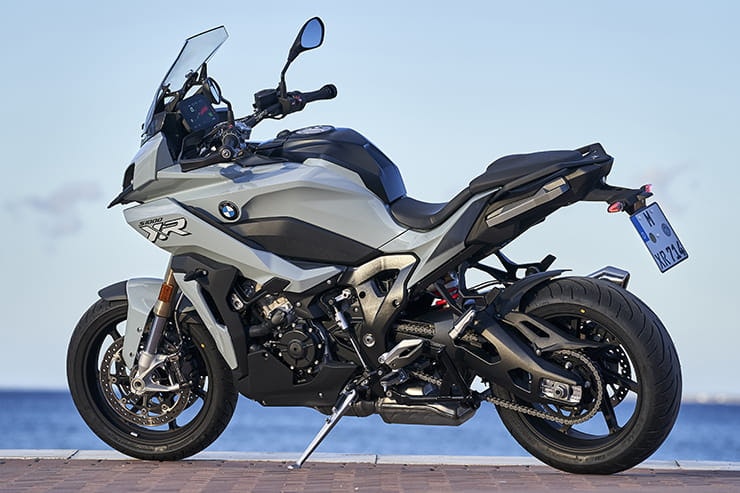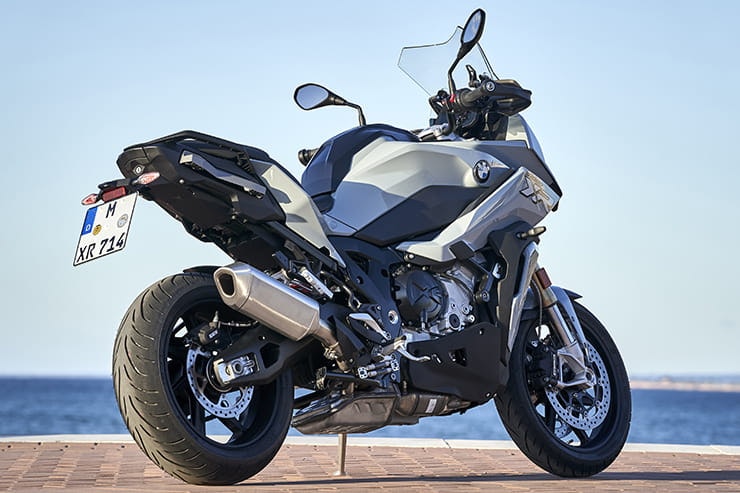BMW S1000XR (2020) -Review | Should you trade up?
By John Milbank
Consumer Editor of Bennetts BikeSocial
02.10.2020
KIT CREDITS
"For 2020, BMW is still offering an incredible motorcycle, but it’s made it that little bit more easy-going for riders demanding more comfort. Ultimately, the new S1000XR is still a blisteringly-fast and versatile machine, but it’s a little more gentlemanly than it used to be…"
Very sporty and exciting in Dynamic Pro riding mode
Great load capacity for touring
It sounds great
You really need to have the Dynamic suspension option
It can feel a bit under-damped
It’s lost a slight edge of sportiness that I so loved about the previous model (but many will prefer it for it)
As the owner of a 2019 BMW S1000XR, I was pretty nervous about the launch of the new 2020 model; had I rushed in too quickly when buying mine?
The previous 2015-2019 model is renowned for vibration through the bars, and we all expected to see the shift-cam motor in the new bike – that would presumably have a big influence on the feel of the machine. But it wasn’t to be. The 2020 XR makes the same peak power and torque as it always did, so it looked to be the same motor.
But it’s not; during the launch presentation, we were told that pretty much every part of the new S1000XR – besides the mirrors and jog wheel – is new…
The styling has changed quite a bit since the 2015-2019 model, on the left
2020 BMW S1000XR Price
Priced from £14,285 for the standard model, and from £16,220 for the TE, prices are broadly similar to the previous year. Compared to the base Kawasaki Versys 1000 at £11,300, it’s quite a jump; even against the top-spec Versys 1000 SE – which costs £14,699 – buyers of a new XR are going to need deeper pockets. Though residual values are likely to be higher on the BMW.
Semi-active suspension is now standard across the XR range (in two different specs), though as with any BMW, it’s worth using the online configurator to see what the options you want will cost.
Power and torque
The peak power and torque figures are exactly the same as they have been since 2015; 162bhp (121kW) @ 11,000rpm and 84 lb-ft (114Nm) @ 9,250rpm, which is plenty on a road bike. Everyone expects more power with an update, but with Euro5 emissions regulations shaping this machine’s performance, it’s impressive to see the numbers the same as they have been. This is not the same engine as last year.
There are clues; compression ratio is 12.5:1, up from 12.0:1. CO2 emissions are 144 g/km –down from 154 g/km – and fuel consumption is slightly improved at a claimed 45.6mpg, up from 42.2mpg. The 999cc power-plant’s inlet cam profiles were first modified, then from there, pretty much the rest of the engine was tweaked. This gave the spec-sheet lovers the numbers they wanted to see, but brought the bike into line with the tougher emission regulations.
Our launch ride was mostly wet, so there weren’t many opportunities to really open the bike up. Given the high performance of the BMW, it’s a shame, but it did feel different in the lower modes; ‘Rain’ felt a lot more gentle than the previous bike, perhaps a nod towards those who didn’t buy the previous model, feeling it was just too sporty. Anecdotally at least, the dealer I bought my bike from told me that a lot of people removed the dongle from the original machine that give them the most aggressive Dynamic Pro riding mode. Personally, that’s part of the reason I bought the bike.
As far as it was possible to open the BMW up on the greasy Spanish roads, the new XR certainly didn’t feel like it was lacking in ‘Dynamic’ and ‘Dynamic Pro’ modes. Anyone new to the model will undoubtedly be impressed by the strong delivery throughout the rev range, but those who have the previous model would be best placed booking a test ride to see how it compares for how and where they ride.
Engine, gearbox and exhaust
According to Max Reuko, product manager for the S1000XR, the shift cam motor that we all expected to come from the new S1000RR was unnecessary in the new XR. In the RR, it’s designed to deliver performance at high revs while also giving the low-to-mid-range punch that the XR has. But as the XR spends less time above 9,000rpm, there was said to be no need to use it. In his words, “shift-cam would have been a shift-scam” in the new S1000XR.
Fourth, fifth and six gears have all been lengthened slightly, resulting in engine speed being lowered by 8% on those cogs – that helps improve economy slightly, make for more relaxed motorway touring and change the speed at which the engine resonates.
The exhaust end can is significantly smaller than the previous model (and it saves 1.2kg), making for a sleeker rear. As a result, the collector box tucked under the engine is bigger now, but you wouldn’t notice it.
Like the previous model, that end-can is a straight-through pipe, and it still sounds great; Euro5 hasn’t ruined it (though Euro5b around the end of 2023 might be a different matter). Part of the reason I bought my 2019 model was the intoxicating scream as the revs build, especially in Dynamic and Dynamic Pro riding modes, but that also came with artificial pops and bangs introduced during the exhaust stroke in the Dynamic riding modes. They make the bike sound even more impressive during hard down-changes, but can be irritating when rolling off while riding through a village. I didn’t notice them on the 2020 model, and wouldn’t be surprised if they’ve been removed for what BMW describes as ‘reduced noise levels for comfort-oriented travel and constant riding’.
The new bike’s clutch is said to be lighter than the previous model, but I couldn’t really tell – it’s still a little weighty for intensive city use, though on the open roads you’ll rarely touch it (assuming you went for the optional quick-shifter). What is noticeable is the fact that the cable-operated clutch is – finally – adjustable for span.
The engine is a little more choppy when rolling off the throttle, and at low revs can feel like it’s hunting. For riding every single day, I prefer the exceptionally smooth delivery of the Kawasaki Versys 1000, though at 118.3bhp (88.2kW) @ 9,000rpm and 75 lb-ft (102Nm) @ 7,500rpm, that 1,043cc motor is tuned for a much more relaxed delivery. Not one for pub-bragging rights then.
Do the bars still vibrate on the 2020 BMW S1000XR?
I felt for any buzz as much as I could on the launch, and while you can of course feel some vibration, it didn’t feel anything like it was on the previous XR. The 2020 bar risers are isolated through rubber inserts that give much more damping than before – you can rock the bars left and right and forward and back now, though it doesn’t make for a detached feel to the steering.
BMW added some rubber damping to the top yoke/bar risers (which was also available to owners of the first machines) around 2016, after which not everyone was bothered by it, but it did get to the point that it started to irritate me if I was sat on a straight road with the revs constantly around 5,500rpm. Fitting Evotech Performance bar end weights helped a lot, but with the slightly heavier Evotech Performance handguard protectors, the buzz was pretty much eliminated on my 2019 model.
2020 BMW S1000XR Economy
During the launch, I saw 40mpg, while another, much smoother journalist achieved 42mpg. There was far less opportunity for aggressive riding on this test but it does seem likely that longer gear ratios and 7% better aerodynamics mean that economy will have been improved in line with BMW’s claimed 3.4mpg boost. I typically get 35mpg out of my own XR, but I tend to ride it quite aggressively. On Fuelly.com – the 2015-2019 model averages 43.8mpg from 21 users, which gives a range of up to 193 miles from the 20 litre tank. A 3.4mpg boost for those users would see range increase to 208 miles.
The swingarm is 1.6kg lighter than the previous model, while the wheels save 1.8kg
Handling, suspension, chassis and weight
BMW claims a 10kg weight saving over the previous model, but that’s when you have the luggage rack and other accessories on the older bike. That’s how most people will experience the machine, but looking at the spec sheets, 2kg has been shaved off. That might sound less impressive, but when you consider how much has been added to the new XR, it’s amazing anything was saved at all.
Max Reuko told me that, in the quest for an improved power-to-weight ratio, there were lots of small savings made across the bike; 2.1kg off the chassis (1.6kg of that in the swingarm), 7.3kg off the drivetrain (5kg from the engine), 0.4kg off the ABS, 1.2kg off the exhaust and 1.8kg off the wheels. It’s initially unclear how an apparent saving of 11.6kg adds up to just 2kg off the bike, but things like LED lights and TFT screens need substantial heat-sinks to keep cool. And while it’s made of magnesium alloy, that new integrated pannier rack will be adding to the mass.
One journalist commented that the 2020 model felt a bit more ‘on its toes’ than he remembered the previous machine; I didn’t notice it, but the conditions weren’t great. Those lighter wheels, a 26mm shorter wheelbase and a slightly steeper steering angle should add up to livelier handling – plus the bars will put your weight fractionally more over the front – but if it is any quicker turning, it’s nothing drastic.
The adaptive headlight is a clever design, but even more amazing is how tiny the LEDs are on the circuit boards; the four miniscule yellow squares in the middle of this board are the high and low beam!
Sitting on springs optimised for a 75kg rider, Dynamic Electronic Suspension Adjustment (D-ESA) is now standard, even on the base model, but D-ESA Pro is only available on the S1000XR TE, or as part of the £1,250 ‘Dynamic Package’ on the base model (which also gives cruise control, keyless ride, quick-shifter and heated grips). D-ESA Pro opens up the ‘Dynamic’ damping setting and self-levelling suspension that automatically compensates for a pillion and luggage – without it you’ll have to press a button to choose between three loads.
D-ESA Pro also offers the ability to press and hold the suspension adjustment button to access ‘minimum’ mode – when the bike has wound the preload up to compensate for additional weight, this will bring it back down (at the expense of slightly reduced spring travel and a lower rear-end); shorter riders touring with their partner will no doubt appreciate this feature, but as a lone rider on the launch, I didn’t notice a difference. If you haven’t got D-ESA Pro, manually selecting the smallest load will set the bike at its lowest point.
Most significantly, the shock and fork internals have been completely redesigned, which has given the new machine a much greater range in its damping adjustment.
The range of automatic damping adjustment has been drastically expanded on the new S1000XR
I’m sure many long-distance touring riders will really appreciate this, but I couldn’t help noticing that the new bike feels under-damped and rather bouncy at times, particularly after leaving smooth motorways. It would firm up, but those few seconds of softness meant I left the new bike permanently in the ‘Dynamic’ damping setting. The problem here is that, unless you have D-ESA Pro, ‘Dynamic’ damping isn’t available.
Even in this mode, the extra range makes it more apparent that the electronic suspension is doing something during the ride, which – personally – I don’t like. On my 2019 S1000XR, I use ‘dynamic’ damping when I’m going for it on twisty back roads, and ‘road’ damping when I want to take things a little more easily (or when I have my wife on the back); current owners considering a trade-in should try the new bike on their roads to see what they think.
2020 BMW S1000XR Brakes
The new brakes are BMW-branded Hayes calipers, similar to those seen on the new R1250GS, and replace the Brembos of the previous model. They’ve got all the bite and power you could wish for on a machine with this power, though at a walking pace, the sometimes softer damping can make them feel a touch sharp.
Comfort over distance and touring
Besides the redesigned top-yoke damping, the bars are now set a little further away from the rider and are 30mm narrower. This makes for a less aggressive riding position that should be more comfortable over long distances, while still maintaining that excellent, commanding riding position.
The screen was always good on the old bike, and here there’s still no significant buffeting. It’s also even easier to flip the screen between low and high settings thanks to a lever built into the mechanism. I’m 5’10”, and with the screen down the air was blown around my face, while with it up the wind hit the top of my lid.
The seat height’s the same on paper (with various options for shorter or taller riders), but a narrower saddle makes for a slightly lower stand-over height. I stumbled while moving the bike on a gravel layby and managed to catch the new XR (just); having lost my balance on – and dropped – my 2019 XR, it appears that the slightly firmer footing afforded by the new saddle is worth it for my 32” inside leg.
That seat has a similar cupped shape to the previous machine; a lot of our ride was wet at 3°C (with patchy oil at one photo stop), so I was relatively tense, but the new riding position does seem to tip the rider forward a little more than before.
The turning circle is excellent, making the bike easy to manoeuvre, while the mirrors give a clear view past your arms.
The new TFT dash is impressively comprehensive yet easy to use
Rider aids and extra equipment / accessories
Dynamic Traction Control (DTC) is standard on the new XR, and it does work; coming out of a greasy corner with a little too much eagerness, the back kicked out, the tyre bit and the bike brought itself back under control swiftly, without loading up the rear shock and potentially leading to a highside. No doubt it felt worse than it looked.
The new TFT dash has a very clear display as standard, though it was scrolling through to the ‘sport’ option that I loved, – it shows brake pressure, DTC intervention and lean angle (as well as revs, speed, trip etc of course). It’s just a shame that you can’t set the dash to default to that display on start-up; every time you turn the bike off, it switches back to the standard dash. A minor point, and maybe something that could be tweaked with a firmware update; what matters is that a huge amount of information is very easily accessible on the new dash, and that you can also connect it to your smartphone via an iOS or Android app.
By far the best manufacturer’s bike software I’ve seen, the BMW Motorrad Connected app is – unlike some others – free, and allows you to view every ride on a very detailed map, with your lean angle, ABS intervention, acceleration and deceleration forces and speed (you can disable this) all displayed. You can also access information on the bike such as battery condition, fuel level and next service. That info stays in the app, so you can check how much fuel you had when you turned the bike off wherever you are.
The app also gives turn-by-turn navigation on the dash, as well as displaying the current speed limit; I prefer full mapping from a sat-nav – and preparation for BMW’s Garmin unit is still an option – but the built-in nav is a useful (and free) addition.
There are some neat extras buried in the ECU too, like hill-hold control, a wheelie control function that’s said to allow the front wheel to lift then stay there, and an emergency stop control that shuts off the throttle under hard braking.
The optional Headlight Pro introduces a cornering function to the full LED lighting – we didn’t get to ride in the dark, but a demonstration showed how effective it is at lighting up the apex of a turn while the bike’s lent over (see the video below). LED lighting can give a rather harsh transition between the lit and unlit areas, and the previous model’s halogen headlights were excellent, so it’ll be interesting to see how effective these are on dark British B-roads. Showing some real thought, BMW has shifted the colour temperature of the high and low beam to be warmer – more like sunlight – which is easier to see with. On the flipside, the DRL (daytime running light) – which is only used to make the bike more visible – has been made cooler as a whiter light is easier to be seen by.
The tail-light has also been redesigned; there isn’t one. The brake and tail illumination is part of the indicators, which makes for a much more visible rear in traffic. It does make it slightly harder to see the turn signals when they’re operating, but the overall visibility is excellent.
As with the previous bike, the optional quick-shifter gives a very clean change at most speeds, so besides being enjoyable to use in more spirited riding, it also helps reduce the times your pillion bashes their helmet into yours.
It’s great to see some space under the seat – something I found lacking on the 2015-2019 machine, and there’s also a really handy (and well sealed) compartment built into the tank, for coins, cards etc.
The previous bike’s 486W alternator didn’t have any problems with most electrical accessories, though the new machine gets a small boost up to 493W.
A Datatool TrakKing can be fitted for free by your dealer – you’ll only pay for the subscription. For more information on trackers, click here.
A rack for a top-box is an optional extra
Will the 2015-2019 S1000XR luggage fit the 2020 model?
The new bike comes with integrated pannier racks for BMW’s luggage – they’re damped, so loading up will have less of an impact on the handling at higher speeds, but it does mean that the fittings are totally different to the luggage on the current bike. If you’re trading your old machine in, you’ll need to buy new luggage, which is likely to cost around £650 for the panniers and about £320 for the top box.
While my S1000XR Sport SE came with BMW’s luggage racks, I removed them and fitted the excellent Givi Trekker kit. I’ve used the same boxes over the years on a Kawasaki Versys 650, my KTM 1050 Adventure and now my XR – the 52 litre top box easily swallows two full-face helmets, while the 33 litre side cases carry as much as my wife and I need. 46 litre panniers are available, but I prefer the narrower boxes for much easier filtering through traffic.
The racks I have are quick-release with a special key, so it’s easy to get the bike looking clean, while the aluminium top-box rack looks great on the tail.
I’m sure Givi and Shad will develop systems for the new bike, for those who want to use their own luggage, but the new integrated rack is a very neat design that helps justify the idea of buying BMW luggage. A top-box rack is available as a £130 option.
The XR always had a very impressive maximum load capacity of 216kg, including rider and pillion. For 2020, that’s gone up to 224kg; excellent for touring couples.
2020 BMW S1000XR UK road test
Despite the world press launch of the 2020 XR in Almeria being really wet, having had the chance to ride the bike on UK roads in glorious sunshine (oh the irony), I haven’t changed any of my opinions, except in noticing that the fuel gauge isn’t always displayed – you can see either that or the trips. There’s plenty of space on the TFT dash, so I can’t understand why BMW decided not to design it in to be always on show.
While UK roads can have plenty of potholes and bumps, I make a point of seeking them out on a press launch, so yes – the softer-than-2019 suspension makes the bike feel less harsh over imperfections, but I still find the damping can end up too soft in some circumstances, leading to a bouncy-feeling. By no stretch is the new S1000XR a bad bike, and BMW obviously knows what it’s doing in making it less aggressive.
As with any motorcycle, reading or watching a road test should arm you with the points you need to consider when you take your test ride. If you’re the owner of the previous model and love the aggression you might not like this version. If you’re after a bloody fast bike that also has a great load capacity and real touring potential, but don’t want to feel like you’re on a wide-barred S1000RR, then you may well love it.
And if you’re riding with your partner on the back, the decision could be even easier…
2020 BMW S1000XR pillion comfort
My wife and I bought our 2019 S1000XR because we loved the styling, the sound, and the way it felt. And while Helen finds it comfortable enough, it is noticeably harsh for her.
So she thinks the new model is great.
At first, she thought that the rear seat seemed a little firm, but after covering 150 miles she was in no doubt that it was well-designed and all-day comfortable.
The BMW top-box also set her back in a good position, so while there will never be a universally anatomically perfect motorcycle, her 5’3” frame fits perfectly.
While we didn’t tour Europe to come to the conclusion that the new XR is a good pillion bike, we didn’t just nip around town and guess how it might feel; our 150 mile route covered fast sweepers, bumpy back-roads and motorways. Helen’s maximum bladder capacity is only about an hour and a half, so we tend to stop reasonably regularly, but having been pillion on pretty much every type of bike over the years, she knows what works. And what doesn’t.
This is definitely a more comfortable machine for a pillion than the previous model, but Helen did miss the pops and bangs when riding in Dynamic and Dynamic Pro modes; she was well aware that it wasn’t as aggressive as the previous bike, and in some ways she did miss that. She also said that she could sense that I wasn’t sitting as comfortably on this model than ours, thanks to the saddle pitching me forward a little, and slight pressure points on my thighs. Again, there is no universal motorcycle (fortunately).
From my point of view, the 2020 BMW S1000XR handles fine with a passenger, the suspension compensating for the extra load with ease, and also automatically raising the preload (I have to press a button on mine). On the other hand, the fact that this bike leans a good 5° further than the previous model on its side stand means pulling up with a pillion on the back (not to mention full luggage) can be disconcerting, especially on awkward cambered lay-bys, even for someone of average height like me.
We still love our 2019 model, and have no plans to change anytime soon. If or when we do chop it in, I can’t help thinking we’d be more likely to be tempted by a GS than the new XR, but you might well think very differently…
S1000XR Pillion comfort
For the solo-riding video, please scroll down the page
2020 BMW S1000XR verdict
From its launch in 2015, the BMW S1000XR was an outstanding road machine for those who wanted aggressive performance along with the commanding riding position of an adventure bike, but without the additional weight that an off-road pretence requires. For 2020, BMW is still offering an incredible motorcycle, but it’s made it that little bit more easy-going for riders demanding more comfort.
When it’s compared to motorcycles like the Kawasaki Versys 1000, the XR’s slight change of direction makes a lot of sense; it’s only those who bought the previous model for its firm, aggressive riding style that might notice the slightly softer feel for 2020.
Ultimately, the 2020 S1000XR is still a blisteringly-fast and versatile machine, but it’s a little more gentlemanly than it used to be. It'll be interesting to see what the BMW M1000XR offers...
"I want one" Bennetts Rewards member opinion
"After 3 years on my BMW S1000RR doing a lot of track days and general commuting and weekend blasts with the lads," says Bennetts Rewards member Mike Taylor, "I was missing my European tours so wanted something not only to explore on, but keep the fire lit for pure speed and track agility! So I bought a 2017 S1000XR. It ticks all the boxes; I’ve taken it on track (and shamed many a sports bike rider), and ridden it over the Alps to Misano, taking in a few of the best passes the area has to offer."The integrated Garmin sat-nav – although expensive – makes touring easy, and I've never had to pre-load a route; I just pick stop points, enter the post code and off we go without issues."I’ve even done my first few laps of Nordschleife on it and it made it easy as it always delivers. For an-all rounder I have yet to find anything as good; I even test rode the Kawasaki H2 SX SE recently and although I thought I’d fall in love with it, I didn’t. The reason I tried it brings me to one small issue I have with the XR... even at 5'11" inches, I find it tall, and with a pillion and luggage it can be difficult tip toeing at stop signs or red lights. Yes you can pay to lower it but I didn’t want to spend more."The other issue I have had is that it seems to eat engine bars! The vibrations although don’t bother me through the handlebars, but they seem to brake the welds on the engine bars and I’m on my third set in three years. Other than that, it's going to take something special to make me trade it in."I want the 2020 S1000XR to be quicker as I tend to thrash the nuts off mine when I’m on my own; I want to be scared of it again. I'd also like it slightly lower, as that would be great for touring so I’m more sure-footed. The TFT dash I’m hoping will be good too, bringing the bike in line with most modern machines as well. "I’ve never had any major issues with the 2017 model, so I'm hoping the BMW build quality remains. Looking forward to my test ride..."
We'll update this review when Mike's had his test ride, to see what he thinks. Bennetts Rewards members can play a key role in our reviews and features, with a lot of opportunities on the way...
Should you trade up?
John compares his 2019 S1000XR to the new 2020 BMW S1000XR…
2020 BMW S1000XR spec
Looking for bike insurance? Get a quote for this motorcycle with Bennetts motorbike insurance
